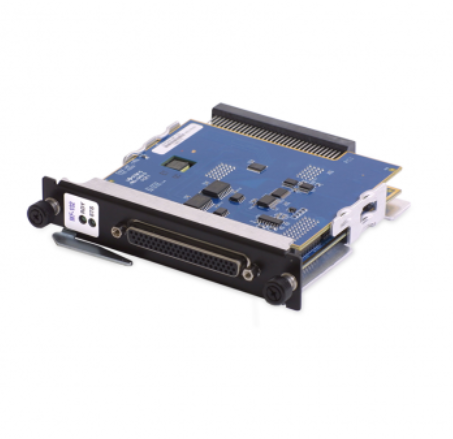United Electronic Industries (UEI) unveils its latest innovation, the DNx-MF-102 multifunction analog and digital I/O board with two CAN ports compatible with all UEI I/O chassis systems.
The board offers a powerful combination of 34 analog and digital I/O channels combined with two CAN ports and one RS-232/422/485 port. This board is integral to any application that requires the interfacing of multiple signals, real-time data acquisition (DAQ), test, and control across various platforms and environments. The flexibility of this board makes them suitable for both critical aerospace and defense systems, high-level industrial processes, and intricate R&D applications.
The DNx-MF-102 is engineered to manage a wide range of input and output signals, making it exceptionally versatile for diverse applications. The board provides 16 channels of eight software-selectable A/D ranges, spanning from ±80V to ±0.156V, with an 18-bit resolution. The ±80V range makes the DNx-MF-102 an ideal measurement solution for automotive, aerospace, and power generation applications, where many DAQ products with a 10V maximum input range would require external signal conditioning. The “high voltage” and “low voltage” configurations are programmable on a per-channel basis.
The board features 16 bits of industrial voltage DIO, with each bit independently configurable as either an input or output. These DIO bits support a broad operating range from 3.3V to 55VDC. The digital inputs include programmable pull-up/down resistors, enabling them to monitor contacts connected to either a supply voltage or ground. An A/D converter senses the inputs, allowing programmable high and low voltage thresholds and facilitating change-of-state detection with a 5μs resolution. The digital outputs can be configured as current sourcing (a switch between Vcc and the output), current sinking (a switch between Gnd and the output), push-pull (connecting to Vcc or Gnd, but not simultaneously), or as a simple switch to Vcc or Gnd.
The board includes three communications ports. The first is an RS-232/422/485 that can be set for any baud rate from 300 baud to 2 Mbaud with 0.01% frequency accuracy. The board also offers two CAN 2.0 ports which support Standard, Fast and Fast+ baud rates, as well as ARINC-825.
The DNx-MF-102 is supported by a complete software suite including support for Windows, Linux and all popular RTOS, as well as support for programming languages and DAQ applications including LabVIEW and MATLAB.
Plus, all UEI PowerDNA products are also backed by UEI’s revolutionary 10-year availability guarantee and a standard three-year hardware warranty, with the ability to extend up to 10-years to mitigate obsolescence issues.
The DNx-MF-102 exemplifies UEI’s dedication to delivering innovative, high-quality solutions by offering unmatched reliability and flexibility, tailored to meet the demands of the industry’s most challenging applications.
Original article source:
FAQ
- What is the New Multifunction Analog and Digital I/O Board?
The multifunction I/O board is a versatile input/output module designed for interfacing with various analog and digital signals. It supports a wide range of applications, including industrial automation, automotive testing, robotics, and data acquisition. The board comes with dual CAN (Controller Area Network) ports for robust and real-time communication.
- What are the key features of the board?
– Analog Inputs/Outputs: Multiple channels for analog inputs and outputs, typically supporting ranges such as 0-10V, 4-20mA, etc.
– Digital Inputs/Outputs: Configurable digital I/O channels for various logic levels.
– Dual CAN Ports: Two CAN ports supporting CAN 2.0A, 2.0B, and CAN FD protocols.
– High-Speed Communication: Supports high-speed data transfer for real-time applications.
– Built-in Signal Conditioning: Onboard signal conditioning for filtering and amplifying signals.
– User-Configurable: Easily configurable through software for different application requirements.
– Wide Operating Temperature Range: Designed for harsh environments with extended temperature range support.
- What applications is this board suitable for?
This board is ideal for:
– Industrial Automation: Process control, monitoring, and equipment management.
– Automotive Testing: Vehicle diagnostics, ECU testing, and sensor interfacing.
– Robotics: Sensor data acquisition, motor control, and communication.
– Research and Development: Prototyping and testing of embedded systems.
- How do the dual CAN ports work?
The dual CAN ports allow the board to communicate with two separate CAN networks simultaneously. This is useful for applications requiring multiple communication channels or when interfacing with different subsystems within a network. Both CAN ports support standard (11-bit) and extended (29-bit) CAN identifiers.
- Is the board programmable?
Yes, the board is programmable. It comes with a software development kit (SDK) that supports popular programming languages such as C, C++, Python, and LabVIEW. This allows users to develop custom applications tailored to their specific needs.
- What is the power supply requirement for the board?
The board typically requires a 12V-24V DC power supply. It also features reverse polarity protection and overvoltage protection to ensure safe operation.
- Can the board be used in harsh environments?
Yes, the board is designed to operate in harsh environments with a wide temperature range (-40°C to +85°C) and is resistant to vibrations and shocks, making it suitable for industrial and automotive applications.
